Dear friends, this week we’ll take you to visit Petra. One of the seven wonders of the world, a UNESCO-listed marvel. A rose-red city, almost as old as time. How to begin, to tell you how amazing it is? We decided to start with some practical Petra tips, on how to get the most out of your visit, as well as some curiosities to find out the best things to do around Petra and help you make the most of your visit!
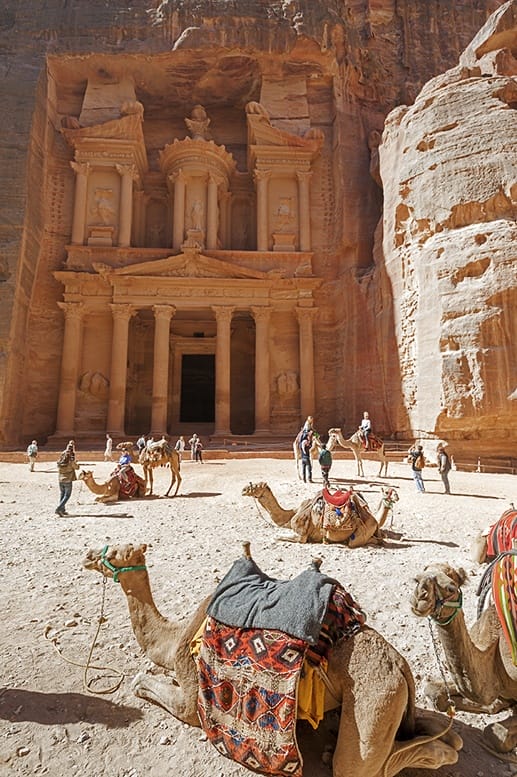
Practical Petra Tips #1: How to get there

Travelling to Petra from Aqaba is fast and convenient. Aqaba is only 2 hours away from the site; whereas travelling from the Jordanian capital Amman takes more than double the time. Those pressed for time can opt for a private car and driver for around 80 JD for the whole day, making Petra a great day trip from Aqaba.
Alternatively, backpackers and indie travellers can take advantage of direct minibus service between Aqaba and Wadi Musa, Petra’s accommodation and service hub. Minibuses cost JD 5 each way and depart when full from downtown Aqaba, near the police station.
Petra is a 3 km walk downhill from Wadi Musa. Taxis cost 2 JD, you may like to take one for the way back uphill if you’re tired after a day sightseeing.
An alternative is heading to Petra on a tour from Jordan or Israel – Abraham is one of the best tour companies in the region!
Looking for more Jordan content? Find out 10 reasons to visit Aqaba and why Wadi Rum is such a great adventure destination!
Practical Petra Tips #2: Where to stay

Wadi Musa to Petra is what Siem Reap is to Angkor Wat and Aguas Calientes to Machu Picchu. The town itself is nothing much, it seems to exist to provide services for tourists and Petra visitors.
There are tons of hotels to choose from across the whole budget spectrum; from 5-star luxury like Movenpick and Petra Marriott, to budget digs like Rocky Mountain Hotel.
We stayed at Tetra Tree Hotel, a recently opened midrange choice offering great value and comfy rooms with a view of Wadi Musa.
Practical Petra Tips #3: How to plan your Petra visit
That was the first surprise for us. Spanning over 60 square kilometers, Petra is HUGE. The Treasury is 6 km from the entrance through the Siq, the narrow canyon of Indiana Jones fame. And that’s just the beginning. Further on from the Treasury you’ll find the Royal Tombs, the Street of Façades, Qasr-al-Bint temple and more. Factor in about 20 km round trip if you’re intending to get to Qasr-al-Bint, where most guided tours end. Comfortable shoes are a must. There are loads of options if you get tired, from horses to donkeys, horse-carts and camels.
Getting to the Monastery, one of Petra’s most stunning sights, takes another couple of hours return and a climb of over 800 steps. There are loads of other places to visit, such as the High Place of Sacrifice with stunning views over the site, and hundreds of nooks and crannies. Go with the flow, you won’t regret it.
My best advice would be to visit Petra over two or three days, a great choice considering that ticket prices are more convenient the longer you visit. One day entrance id 50 JD, two days 55 JD and three days 60.
Also, don’t miss visiting Shobak Castle, a wonderful castle located about 30 km from Petra – highly recommended!
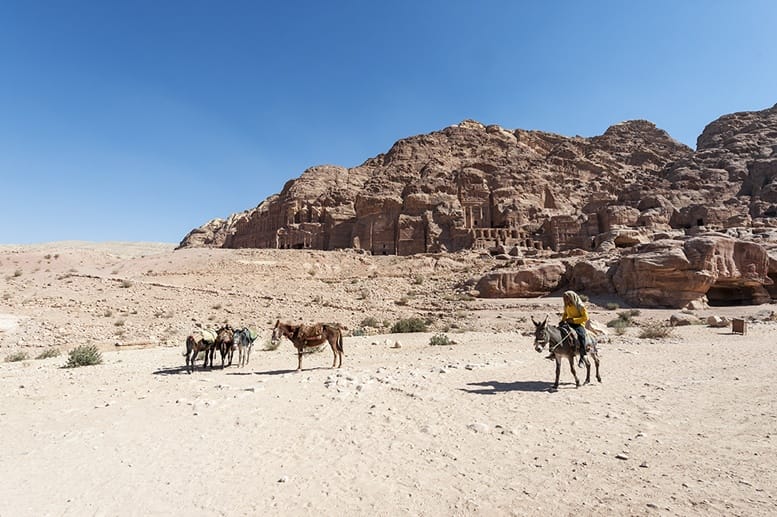
Practical Petra Tips #4: Guide or no guide?
As a budget traveller, I normally ditch guides. After visiting Angkor Wat a few years back, having no clue of how to interpret the complex Hindu iconography, I promised myself I’d stop being so cheap and hire a guide next time.
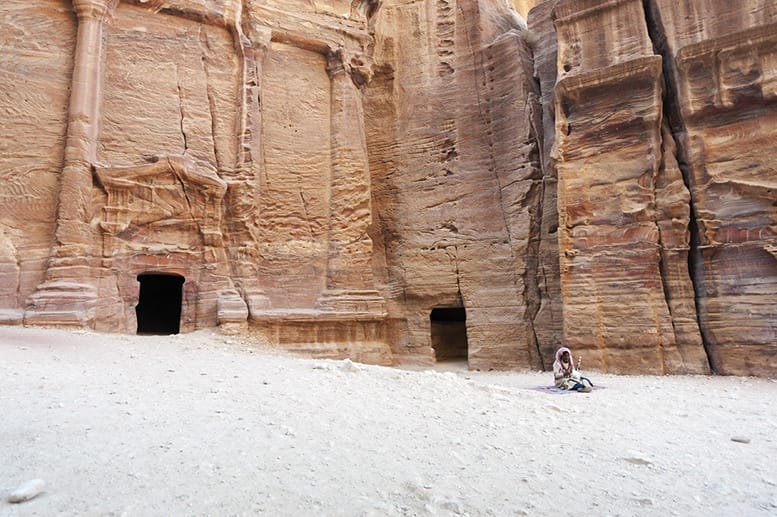
Visiting Petra with a guide was fantastic. Ahmed was a Bedouin, born and bred around Petra, and he gave us countless tips and anecdotes that really brightened our visit. He introduced us not only to Nabatean culture and history, but also to Petra’s engineering wonders. Without him, I think my visit to Petra would have been nothing more than a hazy picture of myself in front of the Treasury.
However, Petra is not cheap. I do recommend hiring a guide, but I understand that many travellers cannot afford to do so. The solution is choosing a good book on the site, and preparing for the visit. If archaeology books make you yawn, a great title is [easyazon_link identifier=”1844082202″ locale=”US” tag=”thecrowdedpla-20″]Married to a Bedouin[/easyazon_link] by Marguerite van Geldermalsen, who still runs a jewellery stall near the Museum. The book offers a great insight on Petra’s recent history and Bedouin culture.
Practical Petra Tips #5: Food and Drinks
Trust me, you won’t go hungry in Petra – Jordanian food is ah-mazing! Snack and drink stalls abound around the site, and there are even proper restaurants. However, as it tends to be at most archaeology sites around the world, prices are rather high.
My tip is to pack some water and snacks before you visit, and have a big lunch after sightseeing at a restaurant in Wadi Musa such as Al Qantarah, offering a great-value lunchtime buffet. If you fancy a drink to remember, head to Cave Bar near Petra Guest House, housed in a 2000 year old Nabatean cave. Cheesy, but stunning at the same time.
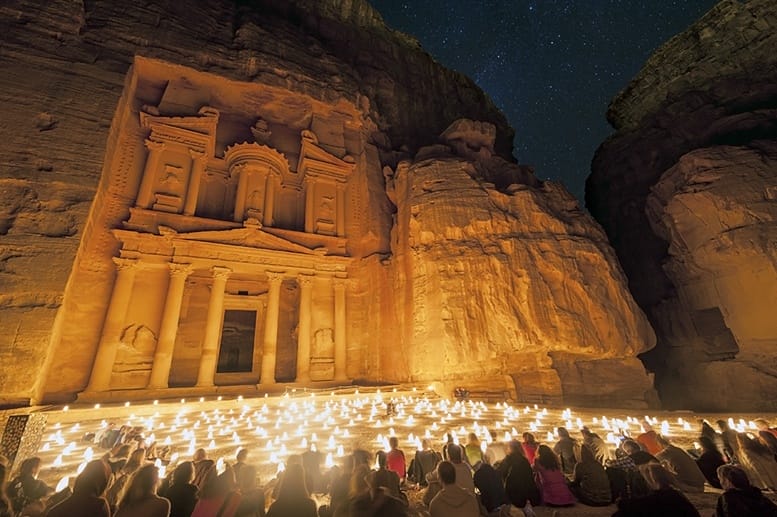
Petra Curiosity #1: All buildings are carved in the rock, except one
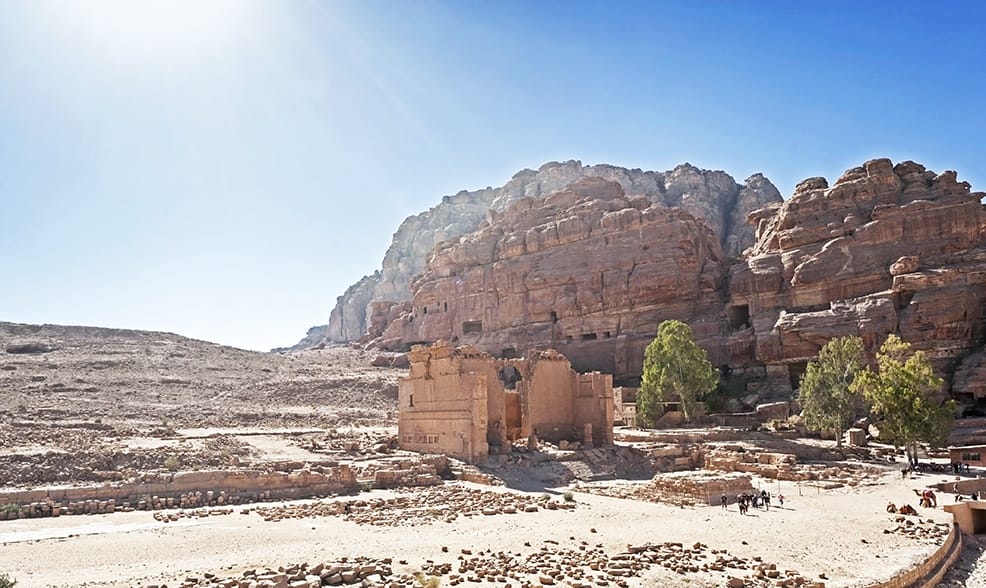
From the iconic Treasury, to the smallest, plainest tomb, all buildings in Petra are carved in the rock face. All but one. Qasr Al Bint sits on the end of the Colonnaded Street, a couple of kilometers downhill from the Treasury. It was believed to be the oldest and most important temple in the city, built with rock slabs cut from the surrounding mountains.
The temple’s modern name, Qasr Al Bint Al Faroun, translates as the Castle of the Pharaoh’s Daughter. The name comes from a local legend of a Pharaoh who, during the times of the Exodus, got tired of chasing Israelites and decided to settle in the area with his court.
Petra Curiosity #2: Nabateans were genius engineers
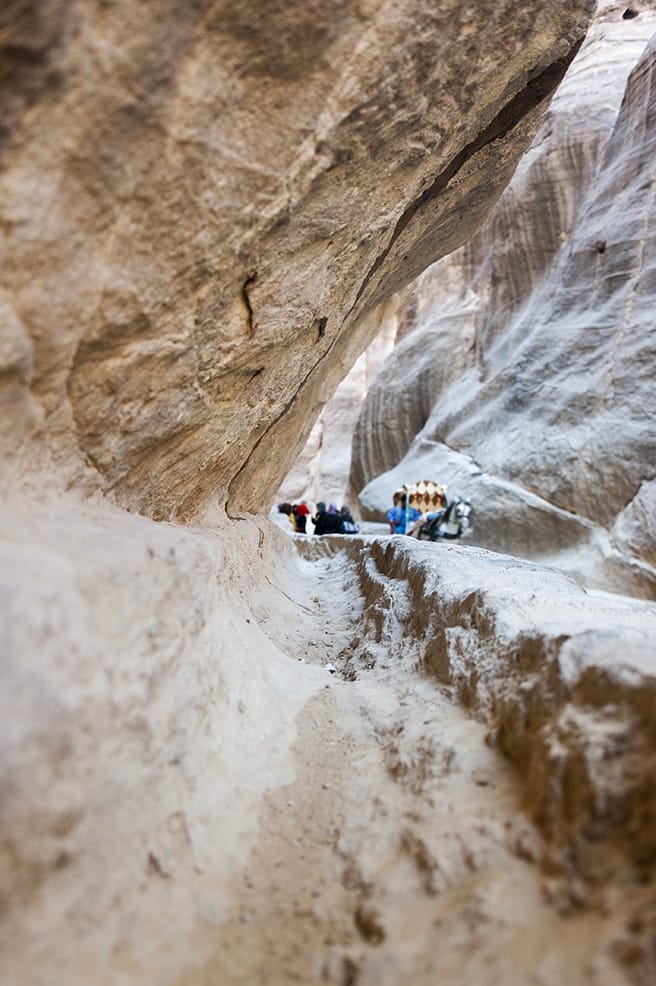
Petra’s rise as Nabatean capital is related to the availability of water. Nabateans built a complex network of cisterns and channels that allowed water to be available throughout the year, even in the driest months.
No drop was wasted; the Siq is lined with a covered channel that was used to bring water from a spring in what is now Wadi Musa. Roads and buildings were lined with water pipes, carefully placed to maintain water pressure constant throughout the city.
There are also hundreds of underground water reservoirs; it is now estimated that Petra’s waterworks carried 40 million liters of water a day, enough to sustain a modern-day population of 100.000. Water was so important that effigies of Dushara, the main Nabatean god, were carved in front of water reservoirs.
Petra Curiosity #3: The Treasury has nothing to do with treasures
The Treasury gets its name from another legend. Depending on the version, the gold from Nabatean trading, or from bandits and pirates, or from a Pharaoh’s treasure, was believed to be stored in an urn on the second level. There are still signs of damage made to the urn, in the hope it will spill its riches. Unfortunately, the urn was solid sandstone.
In fact, the Treasury was a tomb. The main function of Petra was that of the ‘city of tomorrow’; as such, most buildings were tombs or mausoleums.
Curiosity #4: A mix of Egyptian, Greek and Nabatean architecture
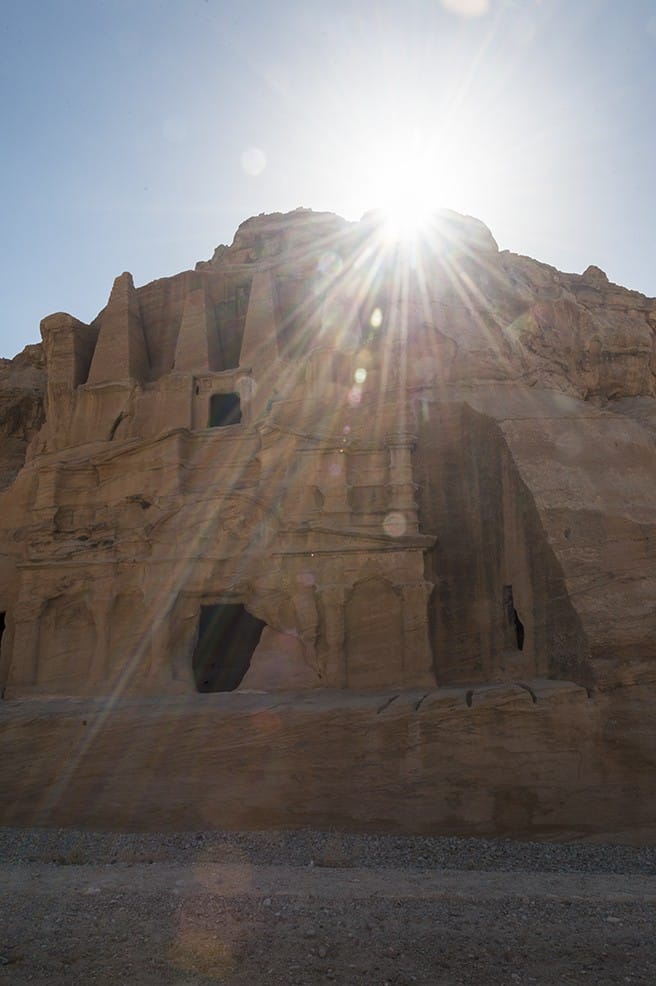
Just after the entrance to the site there is a building that is likely to be unique in its architectural style. It doesn’t sit in a particularly picturesque spot; it is near the Bab al Siq walk, where most visitors breeze through on the horse ride included in the ticket price.
It is worth a look, though. The Obelisk Tomb is the first large and elaborate tomb cut in the rock face, in Nabatean style. The lower part of the facade is reminiscent of a Greek temple, with the usual tympanum and colonnade. The upper part is Egyptian-styled, with four pyramidal obelisks. Between the obelisks there are remains of a statue that was believed to be of the owner of the Tomb.
Curiosity #5: There is another place, even more magical than the Treasury
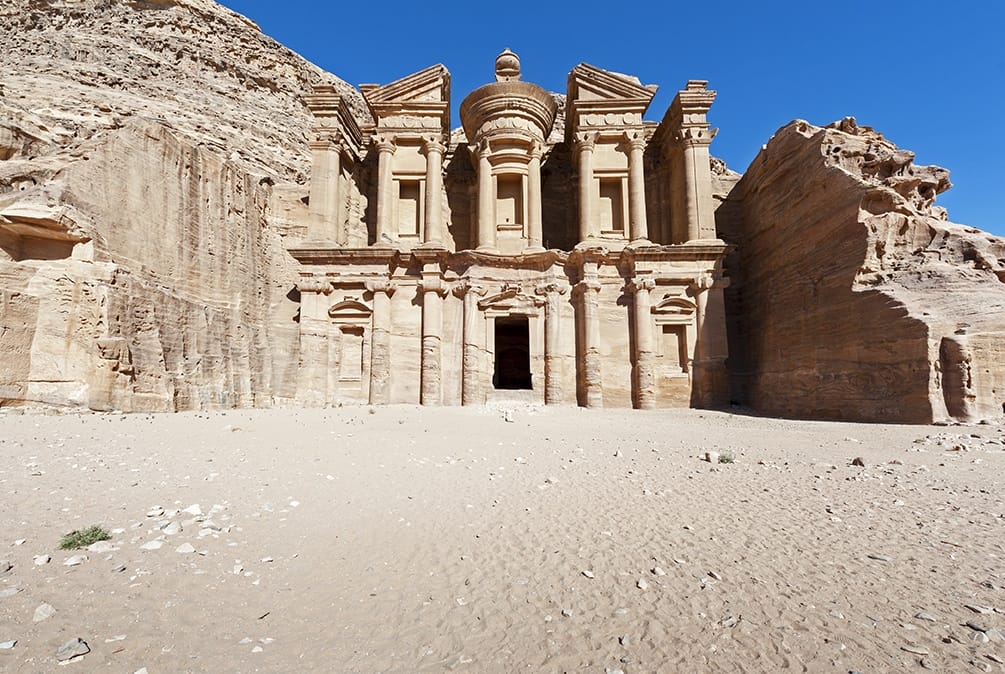
The Treasury is indeed amazing, but the Monastery is even better. It is reached by a flight of 800 steps, weaving through a truly spectacular canyon that offers great views of the surrounding area. Most visitors don’t make it this far.
The way to the Monastery is lined by Bedouin tents, part home past souvenir stalls. When we visited it was lunchtime, people were going about their business, catching up with friends and sharing meals. The top is spellbinding.
The carved façade of the Monastery was set against a deep-blue sky, its golden yellow made brighter by the early afternoon sun. A boy with painted eyes helped me climb into the Monastery. Inside, the place was cool and shady, smelling of damp and centuries.
There were crosses carved over the walls. This is one of the reasons why the place became known as The Monastery, when in fact it was nothing of the sort. It probably started out as a temple, and was used as a church at some point. However, as it is the case with many places in Petra, the reality will remain a mystery, shrouded in local legends and in the dust of time.
And if you really want a magical experience, did you know you could visit Petra by Night?

Really helpful tips, especially as Petra is so huge … Who even knew! Like many incredibly large attractions – Tikal in Guatemala, Uluru in Australia etc – it definitely seems best to explore Petra over a few days. Thanks for the heads up
Thank you Steph! I so wished we had more time in Petra…
Excellent tips! Worth noting, too, that Petra entrance is included on the Jordan Pass. For countries that have to pay for a visa, just those two already represent a bit of savings and it includes entrance to a host of other sites across the country as well.
Thanks! I didn’t know about the Jordan Pass – will update the post!